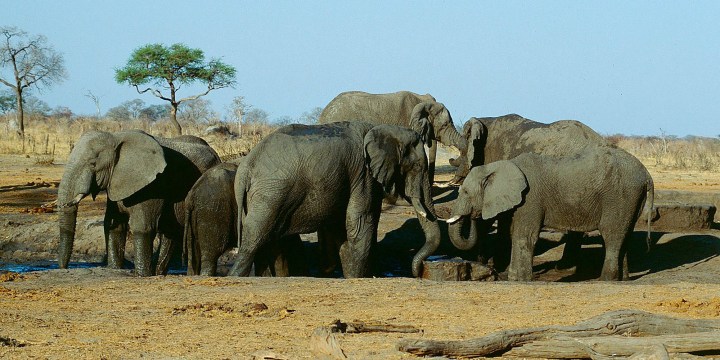SELLING ELEPHANTS
African countries nix Zimbabwe’s efforts to sell live elephants and its ivory stockpiles

Zimbabwe has failed to drum up Africa-wide support to sell live elephants and ivory. Here are some reasons why their trade would be disastrous for elephants.
In a much-hyped conference last month to strong-arm the international wildlife trade organisation CITES into allowing the global sale of elephants and ivory, Zimbabwe last week invited 16 African countries and a range of dignitaries to join its cause.
However, only five countries signed the conference declaration and the summit failed to come up with a continent-wide consensus that could be taken to the CITES (COP19) meeting in Panama in November.
The South African delegation which attended the conference did not include Environment Minister Barabara Creecy and notably did not sign the declaration.
South Africa’s current position is that it will not seek to trade ivory while current circumstances persist. At South Africa’s pre-COP19 meeting on 25 May, no elephant or ivory related proposals were raised.
The Hwange statement demanded non-interference from CITES on domestic trade, sovereignty of states and their right to monetise local wildlife.
It criticised decisions influenced by “non-affected nations” and animal welfare organisations, and called for a review of CITES membership in the face of its “continued unscientific and unwarranted decision-making processes”.
However, should Zimbabwe or other southern African countries decide to leave CITES in order to sell their ivory, any potential consumer country would also have to leave the convention or find itself excluded from the lucrative trade in other CITES-regulated species.

These two elephants were chilled and having fun in the water at Harpoor Dam in the Addo Elephant National Park. Photo: Anne Laing
The bottom line is that Zimbabwe is completely broke, has one of the lowest ratings on the global corruption index and is desperate to monetise its wildlife. It has 130 tonnes of ivory and five tonnes of rhino horn stockpiled, as well as demand from Middle Eastern and Asian countries for live baby elephants.
It was badly aggrieved by the successful lobby by the 32-member African Elephant Coalition at COP18 in 2019 that got CITES to effectively ban trade in live elephants. None of the five signatories of the Hwange summit are part of that coalition.
In a pre-conference briefing in Harare, Zimbabwe’s Environment, Climate, Tourism and Hospitality Industry Minister, Mangaliso Ndlovu, said: “We are clear that we are not going to CITES to beg them. We are going to CITES to present our strong position, a position which we are willing to defend, even if it means being outside CITES.”
Botswana has supported this position. Its director of Wildlife and National Parks, Bakang Senyatso, was reported in the Botswana Gazette (1 June 2022) as insisting that southern African countries reserve the option to opt out of CITES and revert to a willing seller, willing buyer scenario outside CITES processes.
As the dust settles in Hwange, there are a number of issues which beg further analysis.
Why Ramaphosa (apparently) kept mum about multimillion-dollar robbery at his farm
Zimbabwe is lying about the value of its ivory
Zimbabwe’s Minister of Environment has disingenuously valued the country’s stockpile of 130 tonnes of ivory and five tonnes of rhino horn at $600-million in order to justify the sale of these body parts. This distortion of the facts has gained credibility through constant parroting by uncritical journalists.
The most recent data from criminal justice experts finds that unworked elephant ivory sells for about $92/kg on the black market in Africa, while rhino horn is currently selling for $8,683/kg.
Even if you use an optimistic wholesale ivory price of $150/kg, this would value Zimbabwe’s ivory stockpiles at only $19.5-million. That’s a mere 30th of the Zimbabwean minister’s estimate.
The ivory that China bought in 2008 at the last one-off sale for $157/kg was drip-fed by the Chinese authorities to traders at prices ranging between$800 and$1,500 a kilogram. This meant that the bulk of the profits filled Chinese government — not African — coffers and created a large illegal market which drove prices even higher.
It’s illegal to sell seized ivory
Zimbabwe and Botswana want to be allowed to sell ivory supposedly to offset the cost of storing ivory, help finance conservation and mitigate human-elephant conflict.
Elephants are on CITES’ Appendix 1 (no trade) everywhere in the world except Botswana, Namibia, Zimbabwe and South Africa, which were permitted a special exemption to list as Appendix 11 allowing limited trade in a 2008 once-off sale.

A Kenya Wildlife Service (KWS) ranger arranges Ivory at a burning site after offloading them from a container at the KWS headquarters in Nairobi, Kenya, 20 April 2016. EPA-EFE/DANIEL IRUNGU
However, the exception has specific limitations. According to CITES’ Appendicies 1,2 and 3 issued on 22 June 2021, revenue from any sale of ivory must be used exclusively for elephant conservation, but “seized ivory and ivory of unknown origin” is excluded and may not be sold by or to a member country.
The 2008 sales also required both seller and buyer nations to be CITES-approved and as there are currently no such nations, the only way Zimbabwe can have an ivory fire-sale is for it to resign from CITES and find another country which is not a member. However, all potential buying nations are CITES members.
Zimbabwe’s elephant numbers are questionable
To justify any exploitation strategy, you must first say you have too many of the target species and that there are so many in the reserves that they’re a danger to the parks or themselves.
As Kruger Park scientist Sam Ferreira pointed out after attending the conference, elephants don’t have passports and move over the whole southern Africa region, migrating with the rains.
They’re not “owned” by the country they’re moving through, but by themselves as a living nation.
With its economy in the doldrums, Zimbabwe desperately needs foreign exchange and makes no bones about using its wildlife to supply it.
Tourism Minister Prisca Mupfumira was quoted as saying the country has an excess of 30,000 elephants and “we are prepared to ship wild animals to any other interested countries”.
However, there has been no recent census or proper scientific analysis of the area’s elephant-carrying capacity to support this assertion.
In reality, Botswana’s elephant population, at 126,000 is “a population in decline” at the time of the last census in 2018 — a far cry from the oft-repeated claims that their numbers have “swelled”.
Selling ivory stimulates poaching
International trade in ivory has been banned since 1989, following a 10-year period in which African elephant numbers declined by 50%, from 1.3 million to 600,000.
However, in 1999 and 2008, CITES allowed “one-off sales” of stockpiled ivory, to disastrous effect.
The selling prices achieved then were $100/kg and$157/kg respectively following collusion by official Chinese and Japanese buyers.
The intention of CITES in approving the ivory sales was to undercut the black market price of poached ivory. The plan failed miserably.
Instead, the sales led to an increase in demand and in poaching.
The 2008 ivory sale was followed by a 66% increase in illegally traded ivory and a 71% increase in ivory smuggling, as well as a 30% decline in elephant numbers to 415,000 by 2016.
Japan, the other participant in the one-off sales, has continually failed to comply with CITES regulations, allowing its legal and illegal markets to function in parallel.
Responding to the Hwange Elephant Summit, 50 conservation organisations worldwide issued a statement saying that “at a time when demand for ivory is at an historic low and awareness of the need for sustained biodiversity is at an historic high, we urge the international community and policymakers to resist attempts by Zimbabwe and southern African countries to restart ivory trade”.
Killing for training
Elephants are also killed as part of guide training in Zimbabwe, which requires learner hunting guides to shoot an elephant in order to pass their guide qualification.
At the time of writing, there are several thousand trainee guides in the system. It’s believed that all the ivory from this archaic requirement is transferred to the government stockpile.
The problem of ration hunting
Feeding rangers and park staff is beyond the reach of a bankrupt government, so feeding them with high-value species like elephants creates a win-win — your staff are fed and the ivory and skins are stored for later sale.
According to reliable sources who cannot be named for their safety, Zimbabwean rangers shoot elephants (and other wildlife) inside national parks, with annual quotas higher than the surrounding trophy hunting areas.
It’s also believed that the parks and reserves are used to supply other government divisions, including the armed forces, with meat rations.
And finally…
Mangaliso Ndlovu, Zimbabwe’s Environment Minister, confessed that the Hwange Summit was smaller than Zimbabwe had hoped.
“It’s a disappointment for me, the attendance at the summit,” Ndlovu said. “It’s a comfort, though, that the countries that came have 65% of the world’s elephant population.”
The truth is that the only real solution to elephant conservation is to stop all international and local trade.
Repeating failed experiments will simply send a message that it’s acceptable to trade in ivory. Carving factories in China will re-open and demand for ivory will be stimulated.
Poachers will rub their hands in delight. DM/OBP
[hearken id=”daily-maverick/9419″]





















 Become an Insider
Become an Insider
Comments - Please login in order to comment.